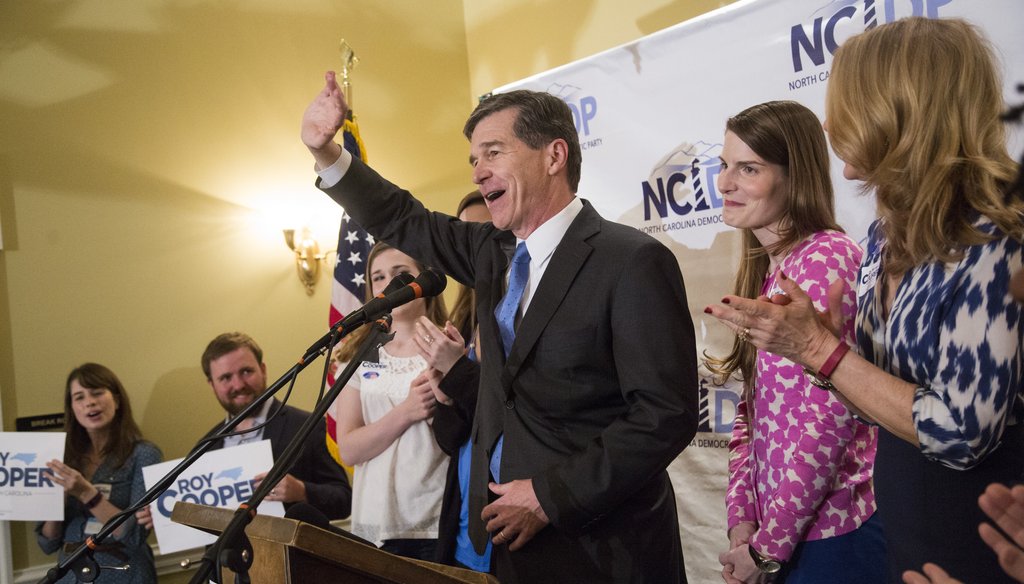



Roy Cooper thanks supporters March 15, 2016, after winning the Democratic nomination for governor
Attorney General Roy Cooper, who has won the Democratic nomination to challenge Republican Gov. Pat McCrory, unveiled his education plan March 8.
Education is a large chunk of the state budget, and it’s a hot topic for both Republicans and Democrats. Cooper’s plan lays out eight basic goals, and it slams McCrory and the Republican-led General Assembly for cutting taxes rather than putting more money into public schools.
The Great Recession began in December 2007 and forced states to slash budgets. North Carolina cut many areas, including K-12 education, and Cooper says funding still hasn’t bounced back.
"North Carolina spends $855 less per student than it did before the Great Recession, and we have one of the lowest per pupil spending levels in the nation," Cooper’s plan reads.
The question of whether higher per-pupil spending generates better academic results is another debate entirely. For now, we’ll just focus on the numbers.
So does Cooper ace this math problem? Or will his former teachers want to dock him points for his statement?
It turns out that like many claims about education funding, it’s complicated – especially the part about "$855 less."
One of the country’s lowest spending levels
First, the easy part. Does North Carolina spend less per student than most states?
The National Education Association, a teacher’s union that has been tracking all sorts of public school funding data for 70 years, says yes.
It reported North Carolina’s per-pupil spending was $8,615 in 2007 (compared with a national average of $9,663). It was $8,867 in 2008 (national average $10,259), and $8,632 in 2014 (national average $11,355).
Those numbers show North Carolina has been falling further behind the national average. NEA’s 2015-16 report isn’t out yet, but in 2014-15 it ranked North Carolina 46th out of 51, counting all the states and Washington, D.C., in per-pupil expenditure. That backs up Cooper’s claim that "we have one of the lowest per pupil spending levels in the nation."
A U.S. Census Bureau report on 2013 per-pupil funding also ranks North Carolina as one of the lowest states. However, the Census hasn’t released more up-to-date numbers.
Face value versus inflation
However, those NEA numbers show North Carolina’s per-pupil spending is actually higher than it was in 2007 and only slightly lower than in 2008, certainly not $855 lower. So what about Cooper’s claim that North Carolina spends $855 less per student than before the recession?
First let’s define two terms: real dollars and nominal dollars. Nominal value refers to a number’s face value. Real value is the inflation-adjusted figure.
Cooper appears at first glance to reference nominal dollars. In that case, he would be wrong.
But even though he didn’t mention inflation, the numbers Cooper cited did account for it. And that’s important, because inflation has risen by about 10 percent since the recession began, according to the federal government’s CPI Inflation Calculator.
For example, if you made $40,000 in 2008 and didn’t make at least $44,034.14 in 2015, you’re facing the same type of hurt that Cooper is talking about here – not a cut per se, but a loss of purchasing power nonetheless.
Cooper’s campaign pointed us to the source of his claim, a report from the left-leaning Center on Budget and Policy Priorities that did find an inflation-adjusted drop of $855 per student since the recession.
But that report was from October 2014 – about 17 months ago. There’s an updated report from this January which shows that in the past year, North Carolina has been moving closer to pre-recession numbers.
In fact, the Center on Budget and Policy Priorities said North Carolina’s increase from 2014 to 2015 was the fifth-largest in the country in terms of percent change.
Other numbers and sources
Unsatisfied with the report from 2014, we looked at some more recent numbers. It turns out that depending on whether you count total funding or just state funding, Cooper’s claim – though based on outdated numbers – is still right in the middle of the range.
Using state numbers from the Department of Public Instruction and combined state, federal and local numbers from the National Education Association, we adjusted the 2008 numbers for inflation. Then we compared it with the most recent available data, which was 2015 for the state and 2014 for all sources combined.
The combined per-pupil spending is down $1,118. State spending by itself is down $481. So Cooper’s claim of "$855 less" is right in the middle of that range.
Our ruling
Cooper is right that North Carolina is one of the states that spends the least per student.
When citing the actual amount he used a report that, while not inaccurate, was outdated. And more context and transparency would’ve been helpful. But Cooper is still right in the general sense that North Carolina’s public schools have less purchasing power than before the recession, and that almost every other state spends more money on education per student than North Carolina.
We rate this claim Mostly True.
Roy Cooper’s education plan
Email interview with Cooper spokesman Jamal Little
Center on Budget and Policy Priorities, Oct. 16, 2014, "Most States Still Funding Schools Less Than Before the Recession"
Center on Budget and Policy Priorities, Jan. 25, 2016, "Most States Have Cut School Funding, and Some Continue Cutting"
N.C. Department of Public Instruction, "Funding North Carolina's Public Schools: Changes Since FY 2008-09"
N.C. Department of Public Instruction, "Spending trends: Historical Funding per ADM," from 2008-09 to 2015-16
NEA, "Ratings and Estimates," 2008-2009
NEA, "Ratings and Estimates," 2014-2015
United States Census Bureau, "Per Pupil Amounts for Current Spending of Public Elementary-Secondary School Systems by State: Fiscal Year 2013 - United States"
North Carolina GOP, "NC House Republicans- State education spending: the facts"
The National Bureau of Economic Research, "US Business Cycle Expansions and Contractions," 1854-2009
In a world of wild talk and fake news, help us stand up for the facts.
